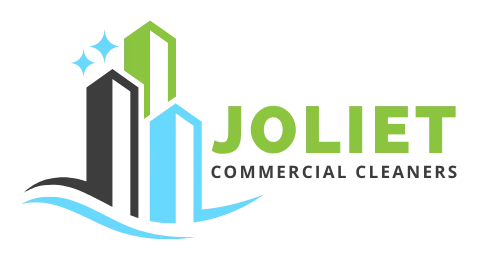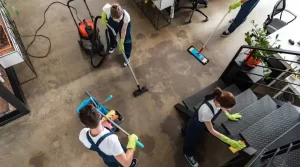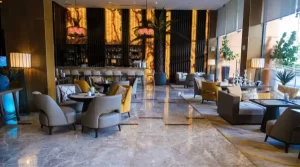According to popular belief, spring is a time for rejuvenation. New buds start to appear, trees fill up, and the grass begins to turn green. Not just Mother Nature is responsible. Many of us have made it a practice to spring clean our living spaces in order to refresh them.
Spring is a time of opportunity for facilities managers. It’s a fantastic opportunity to improve the aesthetic of your facility, get ready for the warmer months ahead, and be proactive with maintenance, even if your building doesn’t have an official “spring cleaning” period.
During Commercial Facility Spring Cleaning, Focus on These 7 Smart Areas
Here are some important topics you might want to address as the season progresses to help you plan your agenda for the spring:
1. Landscaping: Make your property tidier, prettier, and greener.
Employees and visitors to your facility may both view it differently as a result of your landscaping. Any building can look more inviting with a well-maintained landscape. Landscape maintenance is especially important in the spring.
There are a few other landscaping projects you should think about in the spring in addition to getting ready for routine mowing and maintenance:
- new mulch is spread
- the act of weeding or applying a pre-emergent herbicide
- Aeration as well as seeding or overseeding
- pruning bushes
- Resolving any issues that arise
- putting in new shrubs, trees, or flowers
2. Add more windows to your building to let in more light.
The exterior of your building may appear weathered due to winter weather, whether it is severe or mild. The majority of it usually falls on structures with plenty of windows. Given the film on your windows, you might not even be aware of how much natural light you’re losing.
It often feels like you’re switching from SD to HD TV when you get all of your windows cleaned. Everybody in your facility will feel better as a result of the ability to brighten entire rooms. The exterior and interior of every window should be cleaned for the greatest results.
3. Carpet: Take extra care to undo the severe winter damage.
For facility carpets, the winter season is usually the most difficult. In the winter, more moisture, mud, and debris attack carpets and become embedded deeper as a result of foot traffic such as stomping or wiping. Even snow or salt can damage your carpet, detracting from its beauty and possibly resulting in long-term damage.
We can say with absolute certainty that spring is the best time to have your industrial carpet professionally cleaned as a company with over 20 years of experience in the commercial carpet cleaning industry. When that happens, the carpeting in your building really needs to be cleaned extra thoroughly. Your carpet will seem brand-new afterward, and it will also assist to increase its lifespan.
4. Upholstery: Refresh your workplace furniture by adding new cushions.
In the months following winter, not only your carpets but also your upholstery require a comprehensive cleaning. The furnishings in your building are also affected by the additional filth and moisture that tend to enter during the winter, in addition to the bacteria and dead skin cells that are carried in those materials.
Avoid the typical error of forgetting to clean your facility’s furniture when spring cleaning. A professional cleaning will make your leather or upholstered furniture look younger and less dingy.
5. Make sure your HVAC system is ready to keep you cool in the heat.
Make sure your unit is operating at maximum efficiency before switching from heating to cooling your building. To ensure everything is operating properly, you should test your equipment by running it for a while. Aside from that, you should look for any issues that could arise because of aging hardware or broken components.
Additionally, now is the perfect time to dust off all the rarely cleaned crevices in your unit as well as all of your vents and ducts. When this is done, a surprising number of buildings turn out to have mold or pest infestations. It makes sense to take measures with the AC now rather than waiting for a catastrophic system failure on a sweltering July day.
6. Pest control: Stop bugs from overrunning your facility.
In the spring, pest populations also rebirth like nature does. Whether they are bed bugs, termites, spiders, mosquitos, ants, or—gasp—spiders, pests may be a major concern for commercial buildings. Buildings may need to be evacuated for days or weeks while the infestation is dealt with. The best method of pest control is prevention, much like most aspects of facility management.
Have your building sprayed with pest repellent to keep pesky pests out. Know which pests to watch out for in your area. Additionally, if you experienced pest problems in the spring or summer of the previous year, note any exterior elements that may be luring pests, such as landscaping, standing water, food or garbage, or tiny cracks or entry points in the building’s exterior.
7. Complete Facility Check: Anticipate issues and organize your upcoming project
A chance to conduct a thorough facility review is presented at the beginning of each new season. Now is the perfect time to assess the overall condition of your facility. Determine any prospective problems in advance of their occurrence. Consider the future, though.
What technology could use an upgrade? Where may utilizing modern or intelligent technology be beneficial for your facility? What are some future strategies you can use to cut maintenance costs? make a wish list for your facility. Even if you are unable to perform any or all of these things at this time, keep this list handy. Consider setting the spring season’s aim of crossing off one item from your list.







